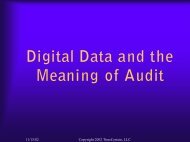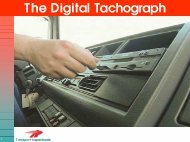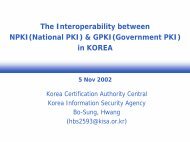The 4th Edition of X.509 [Ref1] and the Internet Certificate and Certificate Revocation ListProfile as defined in RFC3280 [Ref2] provide the most recent implementation guidelines forcertification path validation. However, both sources are silent when it comes to the certificationpath construction process. 3 In fact, there is very little published literature that addressesthe certification path construction issue. Notable exceptions include [Ref3] and [Ref4].Purpose, Scope and AssumptionsThe purpose of this paper is toclarify terminology and review issuesassociated with the certificationpath construction process andto make recommendations whereappropriate.The path construction process can be complex and subject to some degree of trial and error,and there is very little existing literature that discusses issues associated with the certificationpath construction process. Therefore, the purpose of this paper is to clarify terminology andreview issues associated with the certification path construction process and to make recommendationswhere appropriate. However, this paper is not meant to dictate how vendorsMUST perform path construction, nor are we attempting to describe a complete path constructionalgorithm. Vendors are free to implement their own path construction logic as theysee fit. Nonetheless, this paper provides useful information that should be taken into considerationwhen evaluating or implementing certification path construction algorithms.Although this paper discusses issues related to certification path validation, it is not thepurpose of this paper to address certification path validation per se. The 4th Edition of X.509and RFC3280 should be consulted for additional information regarding the certification pathvalidation process.This paper focuses on Version 3 public key certificates as defined in the 4th Edition of theX.509 Recommendation [Ref1]. We recognize that other forms of certificates exist, includingthe Version 1 and Version 2 public key certificates defined in previous Editions of X.509.However, we concentrate on Version 3 public key certificates since they are the most commonform of certificate found in most enterprise and government deployments, and many of theextensions that are only supported with Version 3 are essential in order to control businessrelationships within and across PKI domains. This paper discusses certain Version 3 certificateextensions that can be used to help facilitate the certification path construction process.It should be noted that any discussion associated with these extensions is not applicable in thecontext of Version 1 or Version 2 public key certificates.This paper focuses on Version 3public key certificates as definedin the 4th Edition of the X.509 Recommendation[Ref1]... We concentrateon Version 3 public keycertificates since they are the mostcommon form of certificate foundin most enterprise and governmentdeployments, and many ofthe extensions that are only supportedwith Version 3 are essentialin order to control business relationshipswithin and across PKIdomains.It is recognized that path construction software can be implemented locally (i.e., coupled with theclient system), remotely (i.e., delegated to an external trusted 3rd party), or a combination of both.However, where path construction is performed is irrelevant for the purposes of this paper.Basic ConceptsThe basic structure of the Version 3 public key certificate is illustrated in Figure 1. Certificatesare issued by <strong>Certification</strong> Authorities (CAs) to other CAs or to end-entities (e.g., end-users,devices, Web servers, processes). CAs may also "self-issue" certificates to themselves (this isdiscussed in more detail later).Certificates issued to CAs are known as CA certificates, and certificates issued to end-entitiesare referred to as end-entity certificates. The Basic Constraints certificate extension is used todistinguish between CA certificates and end-entity certificates.The 4th Edition of X.509 defines a relying party as "a user or agent that relies on the data in acertificate in making decisions." Stated another way, a relying party "uses" end-entity certificatesfor some express purpose. For example, a relying party may authenticate a messageoriginator and verify the integrity of the message by "using" the message originator's correspondingcertificate to verify a digital signature associated with the message. A trust anchoris a CA certificate (or more precisely, the public verification key of a CA) used by a relyingparty as the starting point for path validation (which may or may not be the same startingpoint for path construction as discussed further below). A relying party may have one ormore trust anchors, and these trust anchors can be derived from a number of sources. Forexample, a trust anchor may be the public key of a root CA or it may be the public key of theCA that issues one or more certificates directly to the relying party.23This is simply a statement of fact and is not intended to be a criticism. It is generally agreed within theindustry that path construction algorithms should not be subject to standardization. The purpose ofthis paper is to shed light on path construction issues that are not immediately obvious from the existingstandards.PKI Forum: <strong>Understanding</strong> <strong>Certification</strong> <strong>Path</strong> <strong>Construction</strong>: September 2002 PKI Forum: <strong>Understanding</strong> <strong>Certification</strong>2<strong>Path</strong> <strong>Construction</strong>: September 2002
Basic Concepts continuedFigure 1: X.509 Version 3 Public Key Certificate[Digitally Signed by Issuing CA]VersionSerialNumberSignature(Info)Issuer Validity SubjectSubject PublicKey InfoIssuerUnique IDSubjectUnique IDOptionalExtensionsDigitalSignatureAuthority KeyIdentifierSubject KeyIdentifierPossible ExtensionsA certificate that one CA issues toanother CA is referred to as a crosscertificate.Cross-certification can beunilateral or bilateral.A certificate that one CA issues to another CA is referred to as a cross-certificate. Asuperior CA may issue a cross-certificate to a subordinate CA as commonly found inhierarchical trust models. This is referred to as unidirectional or unilateral cross-certification.When CAs issue certificates to each other it is known as mutual or bilateral crosscertification.This is commonly found in distributed trust models. We note that there aremany examples in the industry where the term cross-certification is meant to denote thebilateral case only. However, from a technical perspective cross-certification can also beunilateral. This is reflected in the 4 th Edition of X.509 where a cross-certificate is defined asfollows:Cross certificate - This is a certificate where the issuer and the subject are different CAs.CAs issue certificates to other CAs either as a mechanism to authorize the subject CA'sexistence (e.g. in a strict hierarchy) or to recognize the existence of the subject CA (e.g.in a distributed trust model). The cross-certificate structure is used for both of these.<strong>Certification</strong> path construction involves discovery of a "chain of certificates" between theend-entity certificate and a recognized trust anchor. <strong>Certification</strong> paths can be constructedin the forward direction (i.e., from the end-entity certificate to a recognized trustanchor) or they can be constructed in the reverse direction (i.e., from a recognized trustanchor to the end-entity certificate). Which of these methods is best has been the sourceof some debate over the past few years. We assert that forward direction path constructionis best suited for hierarchical trust models and reverse direction path construction isbest suited for distributed trust models, and this paper will demonstrate that a robustpath construction algorithm must be capable of building paths in both directions. Infact, it may be appropriate to build portions of a certification path using one method andother portions of the certification path using the other.Before we begin to look at the issues surrounding the certification path constructionprocess, let's first explore some fundamentals behind the notion of "certificate chaining".We assert that forward directionpath construction is best suited forhierarchical trust models and reversedirection path construction is bestsuited for distributed trust models,and this paper will demonstrate thata robust path construction algorithmmust be capable of building pathsin both directions.Name ChainingAt the most basic level, a candidate certification path must "name chain" between therecognized trust anchor and the target certificate (i.e., the end-entity certificate). Workingfrom the trust anchor to the target certificate, this means that the Subject Name in onecertificate must be the Issuer Name in the next certificate in the path, and so on. Figure 2helps to illustrate this concept. In this example, the path begins with a self-signed certificatethat contains the public key of the trust anchor. The path ends with the end-entitycertificate. All other certificates within the path are referred to as intermediate CA certificates.Note that every certificate in the chain except for the last one is a CA certificate.PKI Forum: <strong>Understanding</strong> <strong>Certification</strong> <strong>Path</strong> <strong>Construction</strong>: September 2002 3





